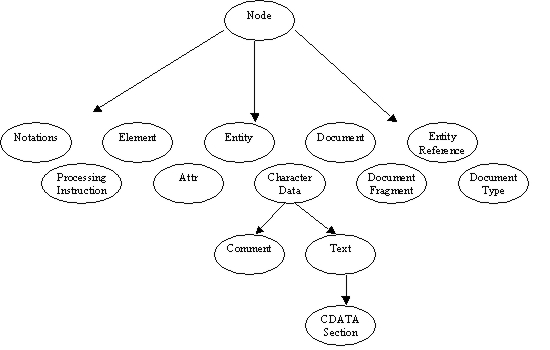|
|
Users Guide | Patterns Reference | WebsydianExpress | Search |
|
|
Users Guide | Patterns Reference | WebsydianExpress | Search |
Introduction Installation Other Uses Parts
DomInterfaces Function Suite
The DomInterfaces function suite is the main suite in Websydian DOM.
The DOM standard defines a number of interfaces each containing various methods and attributes. This structure of the DOM standard is reflected in the DomInterfaces function suite, that scopes one function per interface in the DOM standard. Each of these interface functions scope DOM functions representing methods and attributes contained in the corresponding DOM interfaces:
The DomInterfaces function suite scopes one function for each of the interfaces defined by the DOM standard:
Attr
CharacterData
Comment
Document
DocumentFragment
DocumentType
DomImplementation
Element
Entity
EntityReference
NamedNodeMap
Node
Nodelist
Notation
ProcessingInstruction
Text
Each interface function scopes one function for each method/attribute belonging to the interface.
Each of the functions scoped to an interface function inherits from one of the two abstract functions DomLevel1 or DomLevel2 depending on whether the function implements a DOM Level 1 method/attribute or one belonging to the DOM Level 2.
Each interface in the DOM standard describes an object with methods and attributes associated to it. In Websydian DOM the methods and attributes are implemented as CA Plex functions (called Websydian DOM functions). The DOM functions access the DOM object to which the method or attribute belongs through calls to parser specific API source code.
All DOM functions have at least three parameters ObjectStoreReference, ObjectReference, and ExceptionCode.
ObjectStoreReference
The object store requires this field that
holds a reference to the object store containing all references for a specific
DOM
document. Whenever a new document is created a new ObjectStoreReference will be
created.
ObjectReference
This field contains a reference to the DOM object the function should access.
E.g. when calling the function Node.appendChild the
ObjectReference should contain a reference to a DOM Node
object.
The reference parameters are passed as input to the DOM functions.
All CA Plex fields used to hold references to DOM objects inherit from the abstract field DomObjectReference.
ExceptionCode
ExceptionCode is used as an output parameter and contains the
exception code of any exception raised in the execution of the API source code
associated to the DOM function. Additional information on the exception is
available by popping an element from the error
stack.
Apart from the three parameters ObjectStoreReference, ObjectReference, and ExceptionCode, each DOM function has additional parameters. The DOM function has one input parameter for each parameter in the corresponding DOM method, and one output parameter for each return value in the DOM method.
Example
The DOM Interface Document describes methods and attributes belonging to the Document object. One of the methods described is createAttribute, which creates an Attr object. The createAttribute method has as input the parameter name and returns the Attr object just created. This method is implemented in WSYDOM by the function createAttribute:
Parameters in createAttribute input/output ObjectStoreReference input ObjectReference input name input ExceptionCode output ObjectAttr output
The reference ObjectAttr (which is a DomObjectReference field) obtained when calling createAttribute can be used in subsequent calls to the DOM functions that requires an Attr object.
A DOM Interface consists of a number of methods each of which performs an operation on the object it belongs to. In WSYDOM each DOM method is implemented as an CA Plex function with specified parameters as described above.
A DOM interface consists of a number of attributes, some of which are read-only.
In WSYDOM, these attributes can be accessed through functions scoped to the relevant interface.
Examples:
The Node interface contains the read/write attribute nodeValue. The value of this attribute is read using the function nodeValue_get, and the attribute's value is set using the function nodeValue_set.
The Entity interface contains the read-only attribute publicId. The value of this attribute can be read using the function publicId_get. Because the publicId attribute is read-only, no _set function exists for this attribute.Some DOM interfaces inherit from other DOM interfaces. The inheritance diagram for DOM can be seen in the figure below.

A specific interface can always be used instead of an interface higher up in the inheritance hierarchy. E.g. a reference to an Element object can be used as input to the ObjectReference field in all the functions scoped to the DomInterfaces.Node function suite, because an Element object also is a Node object.
This explains why some of the implemented interfaces in DomInterface do not scope any functions. E.g. the DomInterfaces.Comment interface is empty because the Comment interface inherits all its methods from CharacterData and Node.